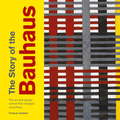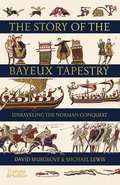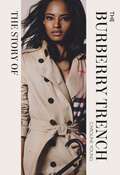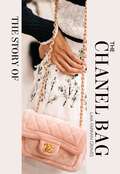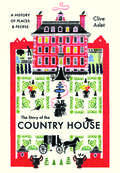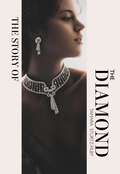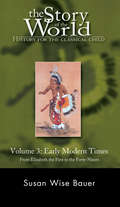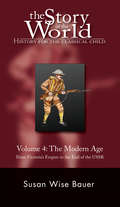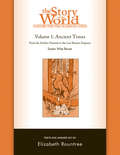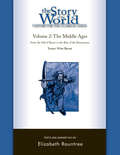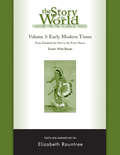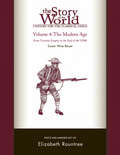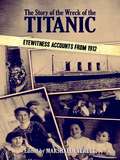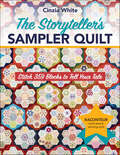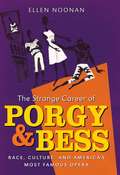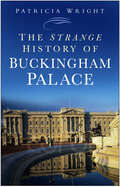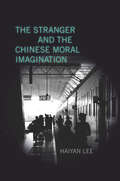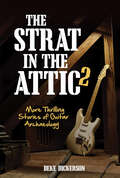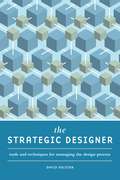- Table View
- List View
The Story of the Bauhaus (The Story of ...)
by Frances AmblerNow 100 years old, the Bauhaus still looks just as fresh today as it did when it began. It was a place to experiment and embrace a new creative freedom. Thanks to this philosophy, the Bauhaus still shapes the world around us. Trace The Story of the Bauhaus through the 100 personalities, designs, ideas and events that shaped this monumental movement. Learn about leaders Paul Klee, Walter Gropius, Anni Albers and Wassily Kandinsky; witness groundbreaking events and wild parties that would revolutionise contemporary design; and discover a range of innovative ideas and new ways of thinking.
The Story of the Bauhaus (The\story Of ... Ser.)
by Frances AmblerNow 100 years old, the Bauhaus still looks just as fresh today as it did when it began. It was a place to experiment and embrace a new creative freedom. Thanks to this philosophy, the Bauhaus still shapes the world around us. Trace The Story of the Bauhaus through the 100 personalities, designs, ideas and events that shaped this monumental movement. Learn about leaders Paul Klee, Walter Gropius, Anni Albers and Wassily Kandinsky; witness groundbreaking events and wild parties that would revolutionise contemporary design; and discover a range of innovative ideas and new ways of thinking.
The Story of the Bayeux Tapestry: Unraveling The Norman Conquest
by Michael Lewis David MusgroveThe definitive and fully illustrated guide to the Bayeux Tapestry. The full history of the events leading up to the Battle of Hastings and the story of the tapestry itself. Most people know that the Bayeux Tapestry depicts the moment when the last Anglo-Saxon king of England, Harold Godwinson, was defeated at the Battle of Hastings in 1066 by his Norman adversary William the Conqueror. However, there is much more to this historic treasure than merely illustrating the outcome of this famous battle. Full of intrigue and violence, the tapestry depicts everything from eleventh-century political and social life—including the political machinations on both sides of the English Channel in the years leading up to the Norman Conquest—to the clash of swords and stamp of hooves on the battle field. Drawing on the latest historical and scientific research, authors David Musgrove and Michael Lewis have written the definitive book on the Bayeux Tapestry, taking readers through its narrative, detailing the life of the tapestry in the centuries that followed its creation, explaining how it got its name, and even offering a new possibility that neither Harold nor William were the true intended king of England. Featuring stunning, full- color photographs throughout, The Story of the Bayeux Tapestry explores the complete tale behind this medieval treasure that continues to amaze nearly one thousand years after its creation.
The Story of the Burberry Trench
by Caroline YoungThe epitome of British heritage fashion, the Burberry trench coat is a beloved wardrobe classic. Practical yet versatile; it is sleek and sexy but also a preppy favourite. Since the launch of the coat in 1912, Burberry has unveiled a selection of styles that has reached iconic stature – and here you will discover their original designs, seasonal adaptations and limited editions.The book also takes a behind-the-scenes look at the craftsmanship, the preloved market and how to authenticate a Burberry. So, whether you are considering buying retail or secondhand, dressing for weather or fashion, this is your ultimate guide to the world's most famous coat.
The Story of the Burberry Trench
by Caroline YoungThe epitome of British heritage fashion, the Burberry trench coat is a beloved wardrobe classic. Practical yet versatile; it is sleek and sexy but also a preppy favourite. Since the launch of the coat in 1912, Burberry has unveiled a selection of styles that has reached iconic stature – and here you will discover their original designs, seasonal adaptations and limited editions.The book also takes a behind-the-scenes look at the craftsmanship, the preloved market and how to authenticate a Burberry. So, whether you are considering buying retail or secondhand, dressing for weather or fashion, this is your ultimate guide to the world's most famous coat.
The Story of the Chanel Bag: Timeless. Elegant. Iconic.
by Laia Farran GravesTimeless and ever-fashionable, the Chanel handbag is the luxury goods statement piece that is always in demand. Since the launch of the 2.55 in 1955, Chanel has unveiled a curated classic selection of styles that has reached iconic stature – and here you will discover their myriad seasonal adaptations, limited editions and special features.From the ultra-rare beaded lucite Cage Flap to the discontinued Diana (named after Princess Di), the So Black to the Graffiti backpack, the book traces the rise of the Chanel bag from the very first designs to today's releases and charts the Chanel bag in popular culture and celebrity fashion.A detailed behind-the-scenes look at the craftsmanship explains the details of quilting, leathers and materials, hardware, labels and stitching, as well as how to authenticate a Chanel bag. Whether you are considering buying retail or second-hand, to celebrate a milestone, commemorate an important event in life or as an investment, this is your ultimate guide to this exclusive – and sometimes elusive – accessory.
The Story of the Chanel Bag: Timeless. Elegant. Iconic.
by Laia Farran GravesTimeless and ever-fashionable, the Chanel handbag is the luxury goods statement piece that is always in demand. Since the launch of the 2.55 in 1955, Chanel has unveiled a curated classic selection of styles that has reached iconic stature – and here you will discover their myriad seasonal adaptations, limited editions and special features.From the ultra-rare beaded lucite Cage Flap to the discontinued Diana (named after Princess Di), the So Black to the Graffiti backpack, the book traces the rise of the Chanel bag from the very first designs to today's releases and charts the Chanel bag in popular culture and celebrity fashion.A detailed behind-the-scenes look at the craftsmanship explains the details of quilting, leathers and materials, hardware, labels and stitching, as well as how to authenticate a Chanel bag. Whether you are considering buying retail or second-hand, to celebrate a milestone, commemorate an important event in life or as an investment, this is your ultimate guide to this exclusive – and sometimes elusive – accessory.
The Story of the Country House: A History of Places and People
by Clive AsletThe fascinating story of the evolution of the country house in Britain, from its Roman precursors to the presentThe Story of the Country House is an authoritative and vivid account of the British country house, exploring how they have evolved with the changing political and economic landscape. Clive Aslet reveals the captivating stories behind individual houses, their architects, and occupants, and paints a vivid picture of the wider context in which the country house in Britain flourished and subsequently fell into decline before enjoying a renaissance in the twenty-first century. The genesis, style, and purpose of architectural masterpieces such as Hardwick Hall, Hatfield House, and Chatsworth are explored, alongside the numerous country houses lost to war and economic decline. We also meet a cavalcade of characters, owners with all their dynastic obsessions and diverse sources of wealth, and architects such as Inigo Jones, Sir John Vanbrugh, Robert Adam, Sir John Soane and A.W.N. Pugin, who dazzled or in some cases outraged their contemporaries. The Story of the Country House takes a fresh look at this enduringly popular building type, exploring why it continues to hold such fascination for us today.
The Story of the Diamond: Timeless. Elegant. Iconic.
by Tamara Sturtz-FilbyA symbol of power, a promise of marriage and a girl's best friend, the diamond is unmatched by any other gemstone in the world. From ancient civilizations and the royal courts of Europe to modern culture, film and fashion, the mystique and glamour of the world's most brilliant natural treasure is told in a story that merges history with gemology, collecting with couture. Celebrating our everlasting fascination with this prized jewel, The Story of the Diamond gives background on merchants, traders and jewellers, from Cartier to Harry Winston, as well as legendary and rare stones, such as the cursed Hope, the stolen Koh-i-Noor and the ransomed Idol's Eye.With indepth information on styles, cuts, colours and carats, and both natural and lab-grown stones, as well as a chapter devoted to engagement rings, there is advice on selecting and buying sustainably sourced diamonds.
The Story of the World Cup
by Richard BrasseyThis is a colourful history of the World Cup from the author of THE STORY OF THE OLYMPICS.From the first tournament in Uruguay to England's legendary 1966 win and beyond, with red cards, penalty shoot-outs and goals galore, there are fun facts football fans can use to impress their family and friends. This book will delight fans of all ages, and is great value for money at £4.99 in full colour.This fun and fascinating exploration of the history of the World Cup is perfect for football fans everywhere.
The Story of the World: From Elizabeth the First to the Forty-Niners (Vol. 3) (Story of the World)
by Susan Wise BauerThis third book in the four-volume narrative history series for elementary students will transform your study of history. The Story of the World has won awards from numerous homeschooling magazines and readers' polls--over 150,000 copies of the series in print! Now more than ever, other cultures are affecting our everyday lives--and our children need to learn about the other countries of the world and their history. Susan Wise Bauer has provided a captivating guide to the history of other lands. Written in an engaging, straightforward manner, The Story of the World: History for the Classical Child; Volume 3: Early Modern Times weaves world history into a story book format. Who was the Sun King? Why did the Luddites go around England smashing machines? And how did samurai become sumo wrestlers? The Story of the World covers the sweep of human history from ancient times until the present. Africa, China, Europe, the Americas--find out what happened all around the world in long-ago times. Designed as a read-aloud project for parents and children to share together, The Story of the World includes each continent and major people group. Volume 3: Early Modern Times is the third of a four volume series and covers the major historical events in the years 1600 to 1850, as well as including maps, illustrations, and tales from each culture. Each Story of the World volume provides a full year of history study when combined with the Activity Book, Audiobook, and Tests--each available separately to accompany each volume of The Story of the World Text Book. Volume 3 Grade Recommendation: Grades 3-8.
The Story of the World: From Victoria's Empire to the End of the USSR (Vol. 4) (Story of the World)
by Susan Wise BauerThis fourth book in the four-volume narrative history series for elementary students will transform your study of history. The Story of the World has won awards from numerous homeschooling magazines and readers' polls--over 150,000 copies of the series in print! Where was the Crystal Palace? Who was the Sick Man of Europe? And how did cow fat start a revolution? Now more than ever, other countries and customs affect our everyday lives--and our children need to learn about the people who live all around the world. Susan Wise Bauer has provided a captivating guide to the history of modern nations all around the world. Written in an engaging, straightforward manner, the final volume of the popular Story of the World series weaves world history into a storybook format, covering major historical events in the years 1850-2000. From the Middle East and China to Africa and the Americas--find out what happened all around the world in the last century and a half. Designed as a read-aloud project for parents and children to share together, The Story of the World includes the stories of each continent and people group. Each Story of the World volume provides a full year of history study when combined with the Activity Book, Audiobook, and Tests--each available separately to accompany each volume of The Story of the World Text Book. Volume 4 Grade Recommendation: Grades 3-8.
The Story of the World: Tests and Answer Key (Vol. 1) (Story of the World)
by Susan Wise Bauer Elizabeth RountreeHistory has been taught in a boring way for far too long. A subject as moving and powerful as humanity's past should be inviting, and when it is told well, it is. Susan Wise Bauer succeeds in telling the captivating story of history with her best-selling history series. Parents and young readers have fallen in love with her narrative history, The Story of the World, and its accompanying Activity Book. Now teachers and home educators can take advantage of a new and valuable learning tool: the Tests and Answer Key package. Included are 42 tests: one for each chapter of The Story of the World. Perfect for evaluating comprehension and retention. The narrative format of The Story of the World helps children remember the famous people, places, and events in history. These tests offer you an easy way to make sure that your child is absorbing the important events from world history. A combination of multiple choice, matching, fill-in-the-blank, and short writing samples allow you to evaluate your child's retention and comprehension of key events in The Story of the World. The Tests package contains an answer key for all tests. These easy-to-use tests and answer keys, successfully used by hundreds of parents and teachers, provide an objective method for measuring retention of key facts, figures, and events from history. A combination of sequencing, matching, short-answer, and essay-style questions gives students a chance to show what they've learned. Used with The Story of the World Text Book and Activity Book (sold separately), the Test and Answer Key gives educators a complete history curriculum for their elementary school students.
The Story of the World: Tests and Answer Key (Vol. 2) (Story of the World)
by Susan Wise Bauer Elizabeth RountreeHistory has been taught in a boring way for far too long. A subject as moving and powerful as humanity's past should be inviting, and when it is told well, it is. Susan Wise Bauer succeeds in telling the captivating story of history with her best-selling history series. Parents and young readers have fallen in love with her narrative history, The Story of the World, and its accompanying Activity Book. Now teachers and home educators can take advantage of a new and valuable learning tool: the Tests and Answer Key package. Included are 42 tests: one for each chapter of The Story of the World. Perfect for evaluating comprehension and retention. The narrative format of The Story of the World helps children remember the famous people, places, and events in history. These tests offer you an easy way to make sure that your child is absorbing the important events from world history. A combination of multiple choice, matching, fill-in-the-blank, and short writing samples allow you to evaluate your child's retention and comprehension of key events in The Story of the World. The Tests package contains an answer key for all tests. These easy-to-use tests and answer keys, successfully used by hundreds of parents and teachers, provide an objective method for measuring retention of key facts, figures, and events from history. A combination of sequencing, matching, short-answer, and essay-style questions gives students a chance to show what they've learned. Used with The Story of the World Text Book and Activity Book (sold separately), the Test and Answer Key gives educators a complete history curriculum for their elementary school students.
The Story of the World: Tests and Answer Key (Vol. 3) (Story of the World)
by Susan Wise Bauer Elizabeth RountreeHistory has been taught in a boring way for far too long. A subject as moving and powerful as humanity's past should be inviting, and when it is told well, it is. Susan Wise Bauer succeeds in telling the captivating story of history with her best-selling history series. Parents and young readers have fallen in love with her narrative history, The Story of the World, and its accompanying Activity Book. Now teachers and home educators can take advantage of a new and valuable learning tool: the Tests and Answer Key package. Included are 42 tests: one for each chapter of The Story of the World. Perfect for evaluating comprehension and retention. The narrative format of The Story of the World helps children remember the famous people, places, and events in history. These tests offer you an easy way to make sure that your child is absorbing the important events from world history. A combination of multiple choice, matching, fill-in-the-blank, and short writing samples allow you to evaluate your child's retention and comprehension of key events in The Story of the World. The Tests package contains an answer key for all tests. These easy-to-use tests and answer keys, successfully used by hundreds of parents and teachers, provide an objective method for measuring retention of key facts, figures, and events from history. A combination of sequencing, matching, short-answer, and essay-style questions gives students a chance to show what they've learned. Used with The Story of the World Text Book and Activity Book (sold separately), the Test and Answer Key gives educators a complete history curriculum for their elementary school students.
The Story of the World: Tests and Answer Key (Vol. 4) (Story of the World)
by Susan Wise Bauer Elizabeth RountreeHistory has been taught in a boring way for far too long. A subject as moving and powerful as humanity's past should be inviting, and when it is told well, it is. Susan Wise Bauer succeeds in telling the captivating story of history with her best-selling history series. Parents and young readers have fallen in love with her narrative history, The Story of the World, and its accompanying Activity Book. Now teachers and home educators can take advantage of a new and valuable learning tool: the Tests and Answer Key package. Included are 42 tests: one for each chapter of The Story of the World. Perfect for evaluating comprehension and retention. The narrative format of The Story of the World helps children remember the famous people, places, and events in history. These tests offer you an easy way to make sure that your child is absorbing the important events from world history. A combination of multiple choice, matching, fill-in-the-blank, and short writing samples allow you to evaluate your child's retention and comprehension of key events in The Story of the World. The Tests package contains an answer key for all tests. These easy-to-use tests and answer keys, successfully used by hundreds of parents and teachers, provide an objective method for measuring retention of key facts, figures, and events from history. A combination of sequencing, matching, short-answer, and essay-style questions gives students a chance to show what they've learned. Used with The Story of the World Text Book and Activity Book (sold separately), the Test and Answer Key gives educators a complete history curriculum for their elementary school students.
The Story of the Wreck of the Titanic: Eyewitness Accounts from 1912 (Dover Maritime Series)
by Marshall EverettPublished in the immediate wake of the famous maritime disaster, this "graphic and thrilling account of the sinking of the greatest Floating Palace ever built" sold briskly to an eager public. A century later, its tragic tale continues to captivate readers. These contemporary reports describe the luxury liner, its passengers, and the circumstances of the wreck. Gripping narratives by survivors recount episodes of heroism and cowardice along with dramatic rescues and moving incidents of self-sacrifice. In addition to chronicling the wide-ranging outpouring of grief and the establishment of many memorials, this fascinating compilation presents expert analysis of the shipwreck's causes and the findings of a Senate investigation convened to determine responsibility for the catastrophe. Historic photographs and specially commissioned drawings appear throughout the book.
The Storyteller’s Sampler Quilt: Stitch 359 Blocks to Tell Your Tale
by Cinzia WhiteRaconteur—The Storyteller’s Collection, a multi-award-winning quilt, is your next take-anywhere project. Sew a collection of miniature pieced hexagons from Cinzia White’s storytelling sampler. Make the king-size quilt your next long-term project, or pick and choose from 359 block designs to make a project of any size! A mix of hand-stitched and machine-pieced 2 ¼” blocks are organized in 59 collections. Full-size foundation paper patterns are included for many of the blocks, with some helpful notes on English paper piecing. It’s perfect for traditional quilters, fans of Dear Jane, and scrap addicts! 359 pieced hexagons! Raconteur, Cinzia White’s award-winning quilt, is the ultimate block-a-day sampler Finish a challenging king-size quilt, or opt for a more manageable size Try foundation-pieced blocks, English paper piecing, or simply sew it all by hand
The Strange Career of Porgy and Bess
by Ellen NoonanCreated by George Gershwin and DuBose Heyward and sung by generations of black performers, Porgy and Bess has been both embraced and reviled since its debut in 1935. In this comprehensive account, Ellen Noonan examines the opera's long history of invention and reinvention as a barometer of twentieth-century American expectations about race, culture, and the struggle for equality. In its surprising endurance lies a myriad of local, national, and international stories.For black performers and commentators, Porgy and Bess was a nexus for debates about cultural representation and racial uplift. White producers, critics, and even audiences spun revealing racial narratives around the show, initially in an attempt to demonstrate its authenticity and later to keep it from becoming discredited or irrelevant. Expertly weaving together the wide-ranging debates over the original novel, Porgy, and its adaptations on stage and film with a history of its intimate ties to Charleston, The Strange Career of "Porgy and Bess" uncovers the complexities behind one of our nation's most long-lived cultural touchstones.
The Strange History of Buckingham Palace
by Patricia WrightBuckingham Palace is one of the most familiar buildings in the world, but who knows the real tales hidden behind its ceremonial gates? Who was the witch that once lived in the royal courtyard? How could courtesans once have plied their trade in front of the present royal windows? How dare a prime minister call the palace a monstrous insult to the nation? This text presents a detailed exploration of the ordinary and sometimes extraordinary people who owned or lived on the land now occupied by the Palace, and of the royal occupants who later inhabited it. The Strange History of Buckingham Palace reveals how Buckingham Palace came to be the place it is today, from the time when it probably formed the escape route from a Roman battle nearly 2000 years ago, to the establishment of the first gentleman's house there in the 17th century, and on into a chequered royal history, which includes an ambitious Saxon queen and James I's plan to found an English silk industry in the Palace gardens.
The Stranger and the Chinese Moral Imagination
by Haiyan LeeIn the last two decades, China has become a dramatically more urban society and hundreds of millions of people have changed residence in the process. Family and communal bonds have been broken in a country once known as "a society of kith and kin. " There has been a pervasive sense of moral crisis in contemporary China, and the new market economy doesn't seem to offer any solutions. This book investigates how the Chinese have coped with the condition of modernity in which strangers are routinely thrust together. Haiyan Lee dismisses the easy answers claiming that this "moral crisis" is merely smoke and mirrors conjured up by paternalistic, overwrought leaders and scholars, or that it can be simply chalked up to the topsy-turvy of a market economy on steroids. Rather, Lee argues that the perception of crisis is itself symptomatic of a deeper problem that has roots in both the Confucian tradition of kinship and the modern state management of stranger sociality. This ambitious work is the first to investigate the figure of the stranger-foreigner, peasant migrant, bourgeois intellectual, class enemy, unattached woman, animal-across literature, film, television, and museum culture. Lee's aim is to show that hope lies with a robust civil society in which literature and the arts play a key role in sharpening the moral faculties and apprenticing readers in the art of living with strangers. In so doing, she makes a historical, comparative, and theoretically informed contribution to the on-going conversation on China's "(un)civil society. "
The Strat in the Attic 2: More Thrilling Stories of Guitar Archaeology
by Deke DickersonDon’t fret! The music historian and guitar sleuth brings you more astounding stories of rare guitar finds and the legends who owned them.Do you dream of finding a 1954 Stratocaster or 1952 Gibson Les Paul online, at a garage sale, or in the local penny saver? How about virtually rubbing elbows with one of your favorite rock legends? Following up his first-of-its-kind The Strat in the Attic, musician, journalist, and “guitarchaeologist” Deke Dickerson shares the stories behind dozens of more astounding finds including:A rarer-than-hens-teeth 1966 Hallmark Swept-Wing that originally belonged to Robbie Krieger of the Doors, stashed away in an attic in Alaska for forty years!A crazy-valuable 1958 Gibson Flying V belonging to a Chicago bluesman—who, it turns out, also happens to have an equally rare 1958 Gibson Explorer!An out-of-the-blue, a “to whom it may concern” email leads the author to a trailer park in Salem, Oregon, where one of Bob Wills and the Texas Playboys’ original 1940s Epiphone Emperor archtops is waiting to be purchased for a song!Luthier R.C. Allen relates the tales of buying Nat “King” Cole Trio guitarist Oscar Moore’s Stromberg Master 400 archtop and of being gifted a 1953 Standel amp from Merle Travis!Buddy Merrill, the amazingly talented guitarist from the Lawrence Welk show, gives his 1970 Micro-Frets Huntington to the author, but only if he “promises to PRACTICE.”Photos of the guitars and other exciting memorabilia round out a package that no vintage-guitar aficionado will want to be without!“The man knows how to tell a great story.” —Jonathan Kellerman, #1 New York Times–bestselling author
The Strategic Designer
by David HolstonThe design profession has been asking itself some important questions lately. How do designers deal with the increasing complexity of design problems? What skills do designers need to be competitive in the future? How do designers become co-creators with clients and audiences? How do designers prove their value to business? Designers are looking for ways to stay competitive in the conceptual economy and address the increasing complexity of design problems. By adopting a process that considers collaboration, context and accountability, designers move from 'makers of things' to 'design strategists. 'The Strategic Designershows designers how to build strong client relationships, elevate their standing with clients, increase project success rates, boost efficiency and enhance their creativity.
The Strategic Designer
by David HolstonThe design profession has been asking itself some important questions lately. How do designers deal with the increasing complexity of design problems? What skills do designers need to be competitive in the future? How do designers become co-creators with clients and audiences? How do designers prove their value to business? Designers are looking for ways to stay competitive in the conceptual economy and address the increasing complexity of design problems. By adopting a process that considers collaboration, context and accountability, designers move from 'makers of things' to 'design strategists.' The Strategic Designer shows designers how to build strong client relationships, elevate their standing with clients, increase project success rates, boost efficiency and enhance their creativity.
The Strategic Designer: Tools & Techniques for Managing the Design Process
by David HolstonThe design profession has been asking itself some important questions lately. How do designers deal with the increasing complexity of design problems? What skills do designers need to be competitive in the future? How do designers become co-creators with clients and audiences? How do designers prove their value to business? Designers are looking for ways to stay competitive in the conceptual economy and address the increasing complexity of design problems. By adopting a process that considers collaboration, context and accountability, designers move from 'makers of things' to 'design strategists.' The Strategic Designer shows designers how to build strong client relationships, elevate their standing with clients, increase project success rates, boost efficiency and enhance their creativity.
